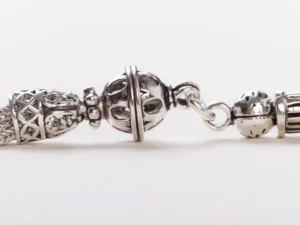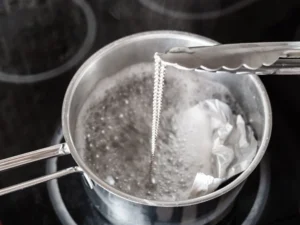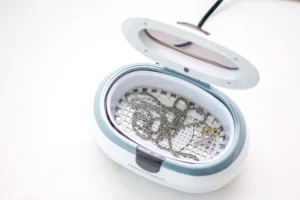Silver jewelry has a lot to offer. Not only is silver the most affordable precious metal, but it’s also one of the shiniest and brightest – it reflects 99% of visible light! Silver is a versatile fashion choice, pairing well with almost anything. It’s no wonder that silver jewelry has been popular for millennia, with its origins traceable to several ancient civilizations.
Perhaps the only downside to silver jewelry is that unlike gold jewelry, it’ll inevitably tarnish at some point. But on the bright side, tarnishing is a natural and harmless chemical reaction that can be reversed. It’s not too much work to restore silver jewelry back to its original luster. So, what are some of the best methods for cleaning silver?
What Makes Silver Tarnish?
First of all, what is tarnishing? It’s the result of a chemical reaction between the metal and sulfur compounds in the air, and/or moisture and oxygen. But for the record, pure silver doesn’t tarnish easily. Silver jewelry is almost never made of 100% pure silver, because it’s way too soft and malleable. A piece of pure silver jewelry would be too fragile to be practical – it would end up bent and misshapen after minimal use.

Most jewelry, flatware and other silver items are made of sterling silver, the classic alloy of 92.5% silver and 7.5% copper. Sterling silver is great because the alloy includes the right amount of copper to make the items super durable. Sterling silver can last a lifetime with proper care. It is, however, prone to tarnishing, which can dull its shine.
Tarnishing takes place when silver inevitably comes into contact with moisture, oxygen or sulfur compounds in the air. A reaction occurs and creates a layer of silver sulfide that will accumulate on the surface of the item, resulting in a dull, discolored appearance.
From a science perspective, it’s pretty interesting. Many different things can lead to tarnishing. Exposure to air, humidity, chemicals (think cleaning supplies), and even natural body oils all play a role in how much and how fast a piece of silver will tarnish.
Can Tarnish Be Prevented?
When it comes to keeping your sterling silver shiny, consistent use and cleaning are key. Rather than waiting until you notice tarnish, it’s ideal to clean your jewelry every other month or so to maintain a good shine. Plus, pieces that are worn and cleaned regularly won’t tarnish as quickly as jewelry that’s tucked away in storage!
There are also steps you can take to prevent and/or minimize tarnishing in the first place. It’s wise to avoid wearing silver while swimming, showering, exercising, doing household chores, cooking, and using hair products or other cosmetics.
Be mindful of how you store your silver jewelry when you’re not wearing it. It should ideally be stored in a cool, dry place – better yet, inside of an airtight container or a tarnish-resistant cloth. You could even go the extra mile and store a few pieces of chalk or silica packets with your jewelry to help absorb any excess moisture.

What Cleans Silver?
People have been coming up with their own ways to clean silver for centuries. From a DIY homemade silver jewelry cleaner to more high-tech methods like ultrasonic cleaning, there are plenty of ways to get the job done.
This DIY method from Popular Science uses some basic chemistry and a few pantry staples – salt, baking soda, water and aluminum foil. It’s pretty straightforward, but the process may need to be repeated once or twice for optimal results. Worth a try!
Cleaning Silver Ultrasonically
Ultrasonic jewelry cleaners are nifty little machines that can be bought for around $40 on the lower end. They can also be used for other things besides jewelry – like glasses, coins and antiques, razor heads, toothbrush heads and more!
So how does ultrasonic cleaning work? Ultrasonic cleaners use high-frequency sounds waves to remove dirt, grime and other contaminants from jewelry.

First the jewelry is placed inside the tank with water, which is often combined with a light detergent or cleaning solution. High-frequency sound waves are generated through a transducer, creating rapid vibrations in the water. The sound waves create microscopic bubbles through a process called cavitation. The bubbles form and burst rapidly, creating tiny shock waves. The energy from the bursting bubbles dislodges dirt and grime from the jewelry, even in those hard-to-reach crevices. Neat!
Keep in mind that certain types of jewelry should be kept away from ultrasonic cleaners. Jewelry pieces with soft gemstones are a prime example. The stones could be chipped or cracked by the ultrasonic vibrations. A few examples of softer gems include opal, topaz, pearl, emerald, amber and turquoise!
Sterling Silver Cleaner
There are tons of different varieties of sterling silver cleaners and polishes out there, from liquids to creams, pastes and even wipes.
If you don’t want to purchase storebought sterling silver cleaner, you could whip up your own silver jewelry cleaner at home with common household ingredients like baking soda, lemon juice and dishwashing liquid.
Commercial sterling silver cleaner is pretty affordable, though – you can find a container for around five bucks. Some varieties require more elbow grease than others, and some may have a funky odor. Many silver cleaning products can be used for other types of metal jewelry as well. Here’s a nice guide from the Spruce to help you pick a silver jewelry cleaner that checks all of your boxes.
Is Cleaning Silver Always Worth It?
There may be times when silver items aren’t worth the effort to clean and de-tarnish. For instance, let’s say you’ve inherited a large collection of sterling silver jewelry or flatware that you don’t want, need, or have space for. You could always just skip the cleaning and send your silver straight to a refinery like Garfield Refining to get paid for the scrap value!
Garfield accepts sterling silver items as-is, tarnished or not. Once we receive your silver items, we’ll perform a melt and assay to determine the exact amount of silver you’ve sent us. Then you’ll be paid based on the current market spot price of silver (which changes daily). Refining is a sustainable option if you have sterling silver that’s not worth cleaning, because your precious metal will be melted down and recycled into something new!
Do you have unwanted silver that you’re looking to refine? Look no further than Garfield Refining, North America’s premier precious metals refinery! With 130+ years in business, we’re committed to getting you the maximum value for your silver or other precious metals such as gold, platinum and palladium. Fill out our shipping form to get started today!

